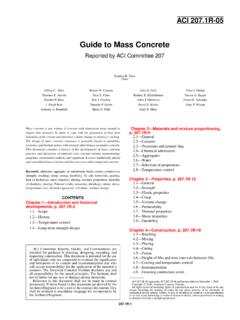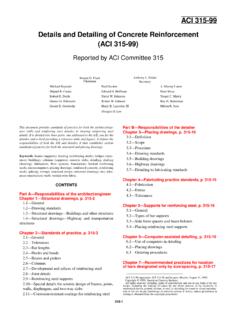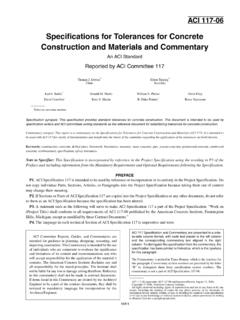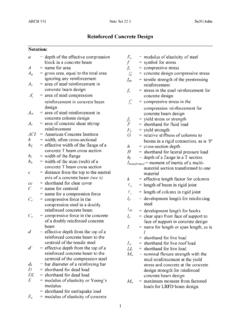Transcription of Guide to Evaluation of Strength Test Results of Concrete
1 ACI 214R-11. Guide to Evaluation of Strength Test Results of Concrete Reported by ACI Committee 214. First Printing April 2011. American Concrete Institute . Advancing Concrete knowledge Guide to Evaluation of Strength Test Results of Concrete Copyright by the American Concrete Institute, Farmington Hills, MI. All rights reserved. This material may not be reproduced or copied, in whole or part, in any printed, mechanical, electronic, film, or other distribution and storage media, without the written consent of ACI. The technical committees responsible for ACI committee reports and standards strive to avoid ambiguities, omissions, and errors in these documents. In spite of these efforts, the users of ACI documents occasionally find information or requirements that may be subject to more than one interpretation or may be incomplete or incorrect.
2 Users who have suggestions for the improvement of ACI documents are requested to contact ACI via the errata website at Proper use of this document includes periodically checking for errata for the most up-to-date revisions. ACI committee documents are intended for the use of individuals who are competent to evaluate the significance and limitations of its content and recommendations and who will accept responsibility for the application of the material it contains. Individuals who use this publication in any way assume all risk and accept total responsibility for the application and use of this information. All information in this publication is provided as is without warranty of any kind, either express or implied, including but not limited to, the implied warranties of merchantability, fitness for a particular purpose or non-infringement.
3 ACI and its members disclaim liability for damages of any kind, including any special, indirect, incidental, or consequential damages, including without limitation, lost revenues or lost profits, which may result from the use of this publication. It is the responsibility of the user of this document to establish health and safety practices appropriate to the specific circumstances involved with its use. ACI does not make any representations with regard to health and safety issues and the use of this document. The user must determine the applicability of all regulatory limitations before applying the document and must comply with all applicable laws and regulations, including but not limited to, United States Occupational Safety and Health Administration (OSHA) health and safety standards.
4 Order information: ACI documents are available in print, by download, on CD-ROM, through electronic subscription, or reprint and may be obtained by contacting ACI. Most ACI standards and committee reports are gathered together in the annually revised ACI Manual of Concrete Practice (MCP). American Concrete Institute 38800 Country Club Drive Farmington Hills, MI 48331. Phone: 248-848-3700. Fax: 248-848-3701. ISBN 978-0-87031-423-0. ACI 214R-11. Guide to Evaluation of Strength Test Results of Concrete Reported by ACI Committee 214. Casimir Bognacki* Jerry Parnes Chair Secretary David J. Ackers Richard D. Gaynor Colin L. Lobo* Bryce P. Simons Madasamy Arockiasamy Alejandro Graf John J. Luciano Luke M. Snell *. William L. Barringer Thomas M. Greene Allyn C.
5 Luke Patrick J. E. Sullivan F. Michael Bartlett* Gilbert J. Haddad Stephen S. Marchese Eugene Takhtovich*. Jerrold L. Brown Kal R. Hindo Richard E. Miller Michael A. Taylor *. Bryan R. Castles Robert S. Jenkins Venkataswamy Ramakrishnan Roger E. Vaughan James E. Cook Alfred L. Kaufman Jr. D. V. Reddy Woodward L. Vogt*. Ronald L. Dilly William F. Kepler David N. Richardson* Orville R. Werner II. Donald E. Dixon Michael L. Leming James M. Shilstone Jr. *. Committee members who prepared this Guide . Statistical procedures provide valuable tools for evaluating the Results of CONTENTS. Concrete Strength tests. Information derived from such procedures is valuable Chapter 1 Introduction, p. 2. in defining design criteria, specifications, and other parameters needed for Introduction structural Evaluation and repair.
6 This Guide discusses variations that occur Summary in Concrete Strength and presents statistical procedures useful in interpreting these variations with respect to specified testing and criteria. Chapter 2 Notation and definitions, p. 2. Keywords: coefficient of variation; Concrete Strength ; normal distribution;. Notation required overdesign; quality control; standard deviation; statistical methods. Definitions Chapter 3 Variations in Strength , p. 3. ACI Committee Reports, Guides, Manuals, and Commentaries General are intended for guidance in planning, designing, executing, Influence of batch-to-batch variations on Concrete and inspecting construction. This document is intended for the use of individuals who are competent to evaluate the Strength significance and limitations of its content and recommendations Influence of within-batch variations on Concrete and who will accept responsibility for the application of the Strength material it contains.
7 The American Concrete Institute disclaims any and all responsibility for the stated principles. The Institute shall not be liable for any loss or damage arising therefrom. Reference to this document shall not be made in contract ACI 214R-11 supersedes 214R-02 and was adopted and published April 2011. documents. If items found in this document are desired by the Copyright 2011, American Concrete Institute. Architect/Engineer to be a part of the contract documents, they All rights reserved including rights of reproduction and use in any form or by any shall be restated in mandatory language for incorporation by means, including the making of copies by any photo process, or by electronic or mechanical device, printed, written, or oral, or recording for sound or visual reproduc- the Architect/Engineer.
8 Tion or for use in any knowledge or retrieval system or device, unless permission in writing is obtained from the copyright proprietors. 1. 2 Guide TO Evaluation OF Strength TEST Results OF Concrete (ACI 214R-11). Chapter 4 Analysis of Strength data, p. 4 batch sample, specimen preparation, curing, and General testing procedures. Statistical functions There are differences in individual mixer batches between Strength variations the front and rear of the mixer, as recognized by ASTM. Interpretation of statistical parameters C94/C94M. For this reason, ACI Field Level I Technicians Standards of control are trained to make composite samples from the central portions of loads. Chapter 5 Criteria, p. 8 Conclusions regarding Concrete compressive Strength can General be derived from a series of tests.
9 The characteristics of Data used to establish minimum required average Concrete Strength can be accurately estimated when an Strength adequate number of tests are conducted in accordance with Criteria for Strength requirements standard practices and test methods. Statistical procedures provide valuable tools when evaluating Chapter 6 Evaluation of data, p. 11. General Strength test Results . Information derived from them is also Numbers of tests valuable in refining design criteria and specifications. This Rejection of doubtful specimens Guide discusses variations in Concrete Strength and presents Additional test requirements statistical procedures useful for interpreting them with Quality-control charts respect to specified testing and acceptance criteria.
10 Additional Evaluation techniques For the statistical procedures described in this Guide to be valid, data should be derived from samples obtained through Chapter 7 References, p. 16 a random sampling plan. Random sampling is when each Referenced standards and reports volume of Concrete has an equal chance of being selected. To Cited references ensure this condition, selection should be made by using an objective mechanism, such as a table of random numbers. CHAPTER 1 INTRODUCTION When sample batches are selected on the basis of the Introduction sampler's judgment, biases are likely to be introduced that will This Guide provides an introduction to the Evaluation of invalidate the analysis. Natrella (1963), Box et al. (2005), and Concrete Strength test Results .



![6ITSVXIH F] %'- 'SQQMXXII - dl.mycivil.ir](/cache/preview/4/b/b/f/2/e/8/1/thumb-4bbf2e81b2b2df04c22714e49f0954ce.jpg)









